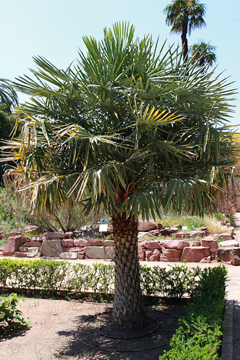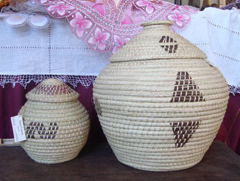 |
|
Falconaumanni wikimedia.org |
 |
| wikimedia.org |
Translate this page:
Summary
Copernica alba or commonly known as Candaray Palm or Wax Palm is an evergreen palm tree in Southern and Western South America that grows up to 25 m in height and 40 cm in girth. It has a cylindrical trunk with greyish, smooth bark. The plant is known for the high quality wax obtained from its leaves. The wax is used to make polishes. The leaves are also used as thatch material and for weaving mats, baskets, and hats. The white wood is resistant and durable, and used for poles, fencing, and building. The fruits are eaten fresh or used for juice and alcoholic drinks. Tips of young plants are also edible.
Physical Characteristics

 Copernicia alba is an evergreen Tree growing to 18 m (59ft) by 3 m (9ft) at a medium rate.
Copernicia alba is an evergreen Tree growing to 18 m (59ft) by 3 m (9ft) at a medium rate.
See above for USDA hardiness. It is hardy to UK zone 10.
Suitable for: light (sandy), medium (loamy) and heavy (clay) soils and prefers well-drained soil. Suitable pH: mildly acid, neutral and basic (mildly alkaline) soils. It can grow in semi-shade (light woodland) or no shade. It prefers moist soil.
UK Hardiness Map
US Hardiness Map
Synonyms
Copernicia australis Becc. Copernicia nigra Morong Copernicia ramulosa Burret Copernicia rubra Moron
Plant Habitats
Edible Uses
Edible Parts: Fruit Shoots
Edible Uses: Drink
The fruit are eaten fresh or used for juice and for alcoholic drinks. The tips of young plants can be eaten.
References More on Edible Uses
Medicinal Uses
Plants For A Future can not take any responsibility for any adverse effects from the use of plants. Always seek advice from a professional before using a plant medicinally.
None known
References More on Medicinal Uses
The Bookshop: Edible Plant Books
Our Latest books on Perennial Plants For Food Forests and Permaculture Gardens in paperback or digital formats.

Edible Tropical Plants
Food Forest Plants for Hotter Conditions: 250+ Plants For Tropical Food Forests & Permaculture Gardens.
More

Edible Temperate Plants
Plants for Your Food Forest: 500 Plants for Temperate Food Forests & Permaculture Gardens.
More

More Books
PFAF have eight books available in paperback and digital formats. Browse the shop for more information.
Shop Now
Other Uses
Basketry Fencing Polish Thatching Wax Weaving Wood
Other Uses: A high quality wax is obtained from the leaves[ 297 ]. It is used to make various high quality polishes[ 297 ]. The leaves can be used for thatching[ 46 , 297 ], and weaving into articles such as mats, baskets and hats[ 297 , 768 ]. The white wood is resistant and durable[ 46 ]. It is used for telegraph poles, fencing and building[ 46 , 297 , 768 ]. landscape uses: Pest tolerant, Specimen Plant. Blooms are very showy
Special Uses
References More on Other Uses
Cultivation details
Plants succeed in moist tropical climates where temperatures never fall below 10c, the average annual rainfall is 1,500mm or more and the driest month has 25mm or more rain[ 297 ]. They can also succeed in drier areas with an annual rainfall as low as 250mm and one month or more where rainfall is below 25mm[ 297 ]. Plants can tolerate occasional light frosts with temperatures down to -2c[ 423 ]. Plants grow well in full sun, even when small[ 297 ]. Prefers a position in light shade[ 423 ].
References Carbon Farming Information and Carbon Sequestration Information
Temperature Converter
Type a value in the Celsius field to convert the value to Fahrenheit:
Fahrenheit:
The PFAF Bookshop
Plants For A Future have a number of books available in paperback and digital form. Book titles include Edible Plants, Edible Perennials, Edible Trees,Edible Shrubs, Woodland Gardening, and Temperate Food Forest Plants. Our new book is Food Forest Plants For Hotter Conditions (Tropical and Sub-Tropical).
Shop Now
Plant Propagation
Seed - pre-soak 24 hours in warm water and sow in containers. The seed can take 2 - 3 months to germinate[ 297 ]. Fresh seed germinates easily[ 314 ].
Other Names
If available other names are mentioned here
Copernica alba or commonly known as Candaray Palm or Wax Palm
Native Range
SOUTHERN AMERICA: Brazil (south), Bolivia, Argentina, Paraguay
Weed Potential
Right plant wrong place. We are currently updating this section.
Please note that a plant may be invasive in one area but may not in your area so it's worth checking.
None Known
Conservation Status
IUCN Red List of Threatened Plants Status : This taxon has not yet been assessed

Growth: S = slow M = medium F = fast. Soil: L = light (sandy) M = medium H = heavy (clay). pH: A = acid N = neutral B = basic (alkaline). Shade: F = full shade S = semi-shade N = no shade. Moisture: D = dry M = Moist We = wet Wa = water.
Now available:
Food Forest Plants for Mediterranean Conditions
350+ Perennial Plants For Mediterranean and Drier Food Forests and Permaculture Gardens.
[Paperback and eBook]
This is the third in Plants For A Future's series of plant guides for food forests tailored to
specific climate zones. Following volumes on temperate and tropical ecosystems, this book focuses
on species suited to Mediterranean conditions—regions with hot, dry summers and cool, wet winters,
often facing the added challenge of climate change.
Read More
Expert comment
Author
Morong. ex Morong. & Britton.
Botanical References
Links / References
For a list of references used on this page please go here
A special thanks to Ken Fern for some of the information used on this page.
Readers comment
| Add a comment |
|
If you have important information about this plant that may help other users please add a comment or link below. Only comments or links that are felt to be directly relevant to a plant will be included. If you think a comment/link or information contained on this page is inaccurate or misleading we would welcome your feedback at [email protected]. If you have questions about a plant please use the Forum on this website as we do not have the resources to answer questions ourselves.
* Please note: the comments by website users are not necessarily those held by PFAF and may give misleading or inaccurate information.
To leave a comment please Register or login here All comments need to be approved so will not appear immediately.
|
Subject : Copernicia alba
|
|
|
|